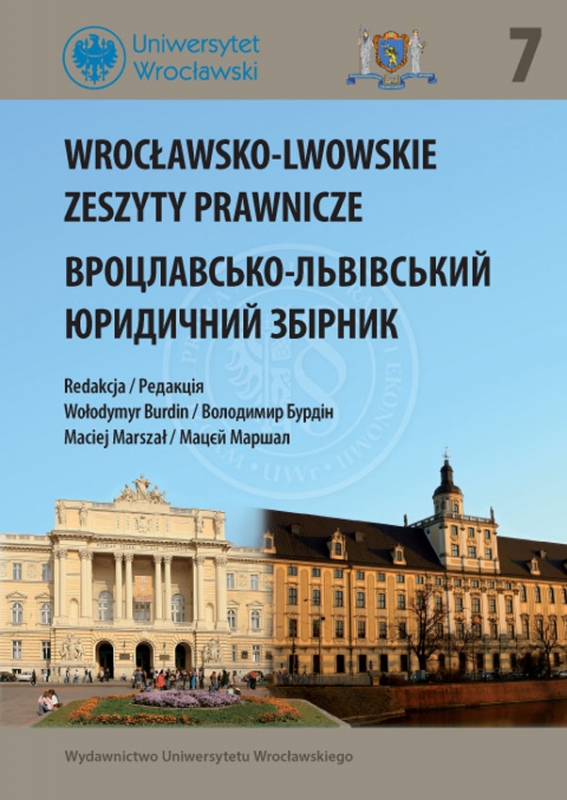

Artykuły

Protection of intellectual property rights to inventions utility models, industrial designs
The article deals with the issue of intellectual property protection for inventions, utility models and industrial designs. The author analyzes the legal regulation of these relations, in particular, such laws as the Civil Code of Ukraine, the Law of Ukraine “On Protection of Rights to Inventions and Utility Models”, Law of Ukraine “On Protection of Rights to Industrial Designs”. The author also analyzes the procedure and methods of patent rights protection. The author defines the general and special methods of the protection of these rights. The main positions of higher courts on the subject of scientific research are considered. The author comes to the conclusion that courts apply mainly methods provided by special legislation in cases of intellectual property protection for inventions, utility models and industrial designs, not by the general one. It is also found that the tax authorites facilitate the protection of intellectual property rights while the goods move through the customs borders of Ukraine by the suspension of customs clearance basing on customs registry data. After the registration of the object in the customs register of intellectual property rights using these data the tax authorites take measures to prevent the moving of counterfeit goods through the customs borders of Ukraine.
The author also argues that the right to use the invention utility model or industrial design is defined as an exclusive one. Therefore, it is only the owner of a patent or other authorized person who can use his patented invention utility model.
It is stated that the burden of proof that the process of manufacturing products identical to those produced using the process protected by the patent rests on the person against whom there are reasonable grounds to believe that they violate the rights of the patent owner. Such a person shall rebut the presumption provided by law which reads that any product, the manufacturing process of which is patented, is considered to be manufactured using this process in the absence of evidence to the contrary.
The author affirms that the publication in the media about the violations of intellectual property rights has a preventive nature.
It is confirmed that only a court can deliver a decision of declaring a patent invalid; and the list of grounds for such a decision is exhaustive. The typical grounds for patent invalidation is the absence of the terms of legal protection granting.
It is stated, that a court declaring a patent invalid is empowered to deliver a decision to oblige the State Intellectual Property Service of Ukraine to submit the data regarding the invalidation of the relevant patent for an invention utility model, industrial design to the State Patent Register of Ukraine and publish this information in the official journal “Industrial Property”.
The author concludes that a court during proceedings may combine several special methods of protection in the same case.
Ochrona praw własności intelektualnej w zakresie wynalazków wzorów użytkowych i wzorów przemysłowych
W artykule podjęta została kwestia ochrony własności przemysłowej. Autor analizuje regulacje prawne dotyczące tych stosunków prawnych, w tym przepisy Kodeksu Cywilnego Ukrainy, Ustawy Ukrainy „O ochronie praw do wynalazków i wzorów użytkowych”, Ustawy Ukrainy „O ochronie praw do wzorów przemysłowych”. W artykule zaprezentowane zostały procedury i sposoby ochrony praw patentowych. Ustalone zostało istnienie ogólnych i szczególnych sposobów ochrony tych praw. Autor dokonał analizy opinii sądów instancji wyższej na temat badań naukowych i stwierdził, że w sprawach dotyczących ochrony własności przemysłowej najczęściej stosowane są przez sądy metody ochrony ustalone w ustawodawstwie szczególnym. Stwierdził, że organy podatkowe przyczyniają się do ochrony praw własności intelektualnej, co obserwujemy podczas przepływu towarów przez granicę celną Ukrainy. Służą temu dane rejestru celnego, uzyskiwane podczas kontroli celnej. Po rejestracji towaru w celnym rejestrze ruchomości organy podatkowe na podstawie danych rejestru podejmują kroki w celu zapobieżenia przepływu towarów fałszywych przez granicę celną Ukrainy. Autor udowodnił, że prawo do eksploatowania wynalazku wzoru użytkowego lub wzóru przemysłowego jest uznawane jako wyłączne, ponieważ tylko właściciel patentu lub inna upoważniona osoba jest uprawniona do eksploatowania własności intelektualnej w zakresie danego z wynalazku wzoru użytkowego.
Stwierdzone zostało, że ciężar udowodnienia tego, że proces wytwarzania produktów identycznych do tych, które były wyprodukowane z zastosowaniem chronionej patentem metody, spoczywa na osobie podejrzanej o naruszenie praw intelektualnych. Taka osoba musi obalić ustalone przez prawo domniemanie braku autentyczności danego towaru. Autor twierdzi, że publikacje w mediach dotyczące naruszeń praw własności intelektualnej mają charakter prewencyjny i odstraszają potencjalnych oszustów. Ponadto dowodzi, że tylko sąd może podjąć decyzję w sprawie uznania nieważności patentu, a wykaz podstaw do uznania nieważności patentu jest wyczerpujący. Głównymi podstawami do uznania patentu za nieważny jest brak chronionych prawem dóbr. Sąd w sporach dotyczących uznawania nieważności patentu może zobowiązać Państwowy Urząd Patentowy Ukrainy do wniesienia do Państwowego Rejestru Patentów Ukrainy informacji o unieważnieniu odpowiedniego patentu w zakresie wynalazku wzoru użytkowego i wzoru przemysłowego, nakładając jednocześnie na Urząd Patentowy obowiązek opublikowania tej informacji w Dzienniku Urzędowym pt. „Własność przemysłowa”.